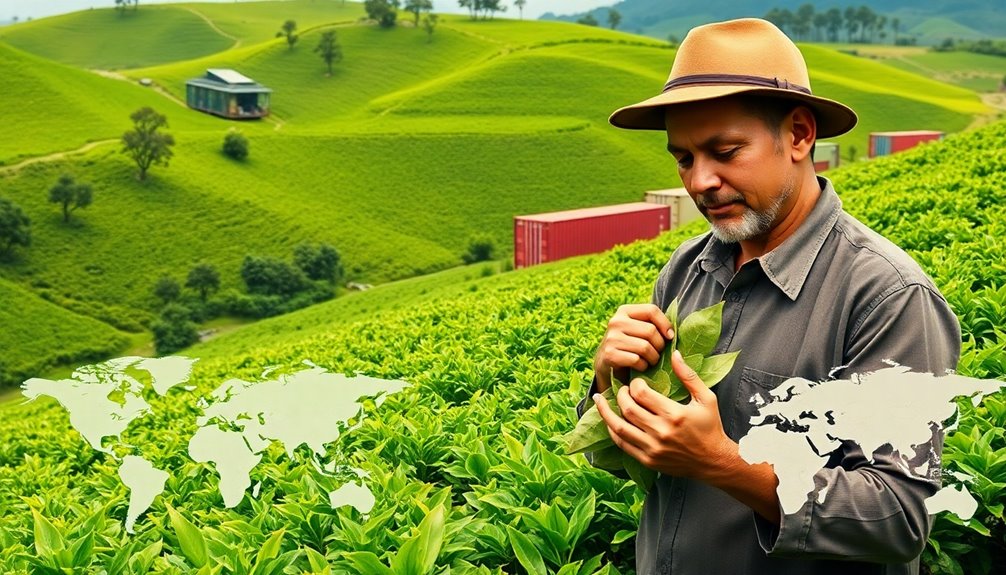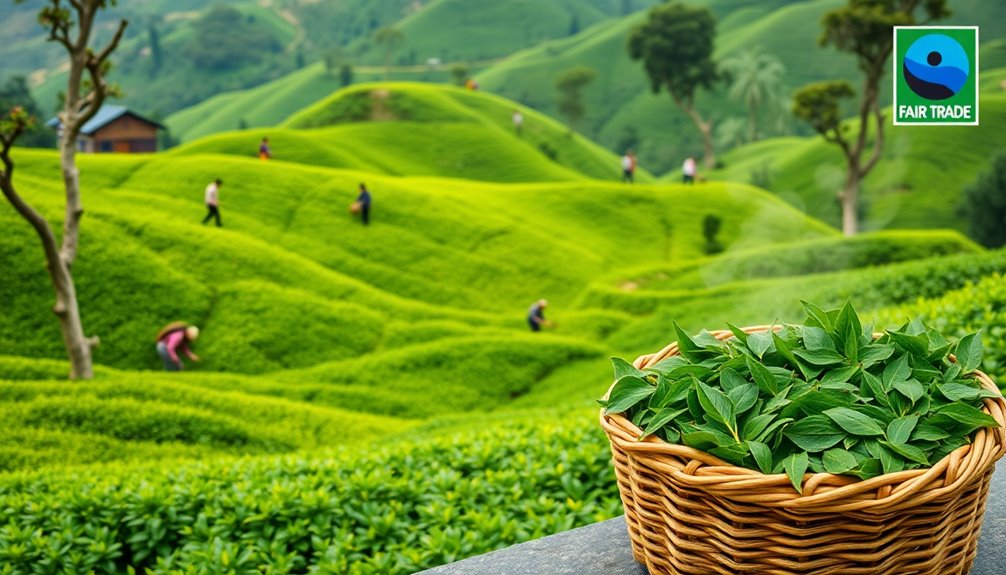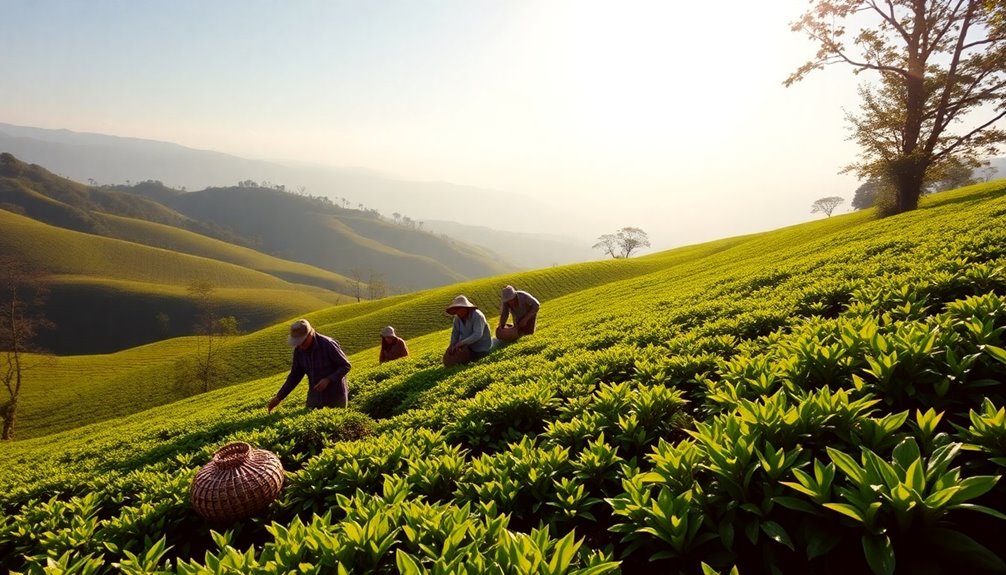Trade wars are really shaking up the tea industry, and you're likely noticing changes at the store. Because of tariffs, especially on Chinese tea, prices have shot up! Taxes on these teas have jumped from about 3% to nearly 20%. This has led to a 17% drop in imports from China. Instead, more tea is now coming from places like Sri Lanka, which saw a boost of 15% in imports. These shifts can affect what's available on the shelves and may even change your tea choices. Curious about how this might affect your favorite cup of tea? Stick with us!
Key Takeaways
- Tariffs on Chinese tea have increased from 3% to nearly 20%, driving up prices for consumers and retailers.
- The U.S. experienced a 17% drop in tea imports from China, impacting availability and sourcing strategies.
- Importers are shifting to alternative suppliers like Sri Lanka, which saw a 15% increase in tea imports amid higher tariffs.
- Supply chain disruptions caused by tariffs create market uncertainty, affecting pricing dynamics and predictability for businesses.
- Average American households face an additional $1,000 in costs due to tariff-related price increases, impacting overall tea consumption.
Introduction

As the U.S.-China trade war escalates, it's clear that the tea industry isn't immune to its effects. You mightn't think about it, but the tea you love has been impacted by these trade tensions.
Since the trade war began in 2018, tariffs on Chinese goods, including tea, have changed the way people buy and sell their favorite brews. In 2020, a truce lowered some tariffs, but the worry about high prices still lingered.
U.S. tea imports from China dropped by 17%, while imports from other countries like Sri Lanka increased. This shift shows how importers are looking for new sources to keep prices manageable.
With the U.S. tea industry valued at a whopping $17.9 billion, you might be noticing that specialty tea prices are rising, too. Retailers are adjusting their prices, and that can affect what you pay at the store.
The trade war is reshaping the tea landscape, making it important for you to stay informed about how these changes can impact your next cup of tea. Every sip now carries a story of trade and tariffs!
Tariffs on Imported Tea

Tariffs on imported tea have dramatically shifted the landscape for both consumers and retailers alike. The U.S. tea industry, worth a whopping $17.9 billion, faced challenges when tariffs on Chinese tea were threatened at rates between 25-30%. This led to a significant 17% drop in total tea imports from China last year.
As a result, specialty tea retailers had to raise prices on premium Chinese teas, which affected what you pay at the store.
With nearly two-thirds of U.S. tea imports from China now covered by tariffs, the average tax on these imports skyrocketed from 3% to almost 20%. This change impacts the pricing of your favorite teas, making it more expensive to enjoy that delicious cup.
Even though the declared value of Chinese green tea imports has been small, you can expect prices to rise more as tariffs continue to shake things up.
While trade with China is crucial for the tea market, the tariffs have created a ripple effect. You might find it harder to get the same tasty teas, and when you do, they could cost a little more.
Tariffs Impact Tea Pricing Dynamics
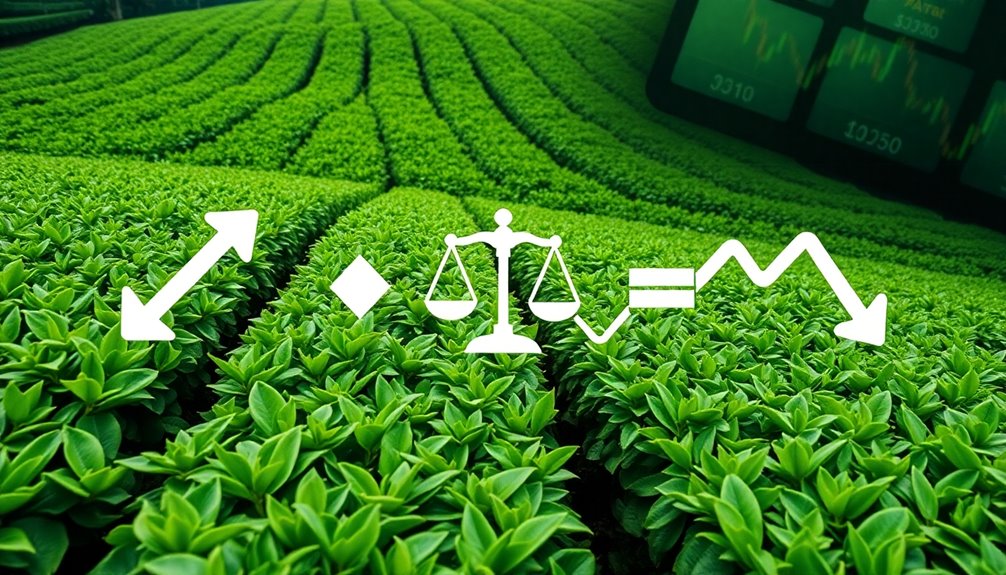
The recent changes in tariff policies have directly influenced tea pricing dynamics, leaving consumers and retailers to navigate a volatile market. You might've heard about the tariffs on Chinese goods, especially tea, which caused quite a stir in the $17.9 billion tea industry.
Initially, tariffs were set at a high rate of 25-30%, making tea prices jump. Thankfully, after a truce in January, import duties dropped from 15% to 7.5%. This reduction helped a bit, but prices for premium Chinese teas still went up.
Because of these tariffs, imports from China decreased by 17%, while imports from Sri Lanka increased by 15%. This shift shows how pricing strategies in the tea market are changing. Specialty tea retailers have had to adjust their prices, and that affects what you pay at the store.
With JP Morgan estimating that the average American household faces an extra $1,000 in costs due to tariffs, it's clear that consumer spending on tea and other imported goods can take a hit. Overall, the tea industry's pricing dynamics are in a state of flux, making it an exciting time to watch how things unfold!
Global Tea Sourcing Shifts
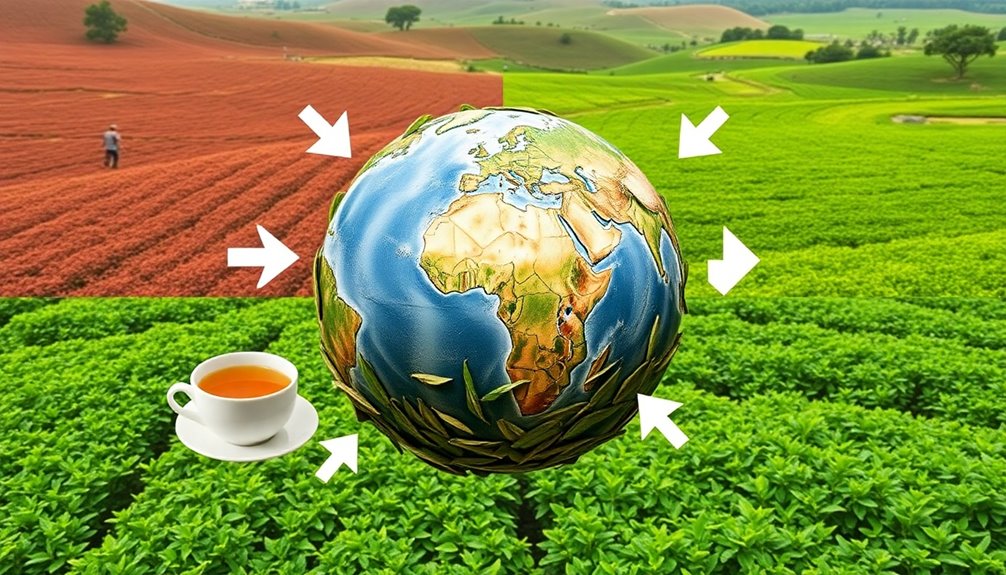
Recent tariff changes have prompted significant shifts in global tea sourcing. You might notice that tea imports from China have dropped by 17% as trade tensions heat up. Instead, more tea is coming from Sri Lanka, which saw a 15% increase. This change is mainly due to the higher tariffs on Chinese teas. With tariffs now reaching nearly 20%, it's no wonder specialty tea retailers are adjusting their prices, which can affect what you decide to buy.
In the specialty tea market, there's a split between legal importers who follow the rules and smugglers who try to avoid tariffs. This division is reshaping sourcing strategies. Importers are feeling the pinch from rising costs, making it essential for them to think carefully about where they get their tea.
As the overall tea market in the U.S. is valued at a whopping $17.9 billion, these shifts mean you might see some price increases when buying your favorite blends.
Supply Chain Disruptions
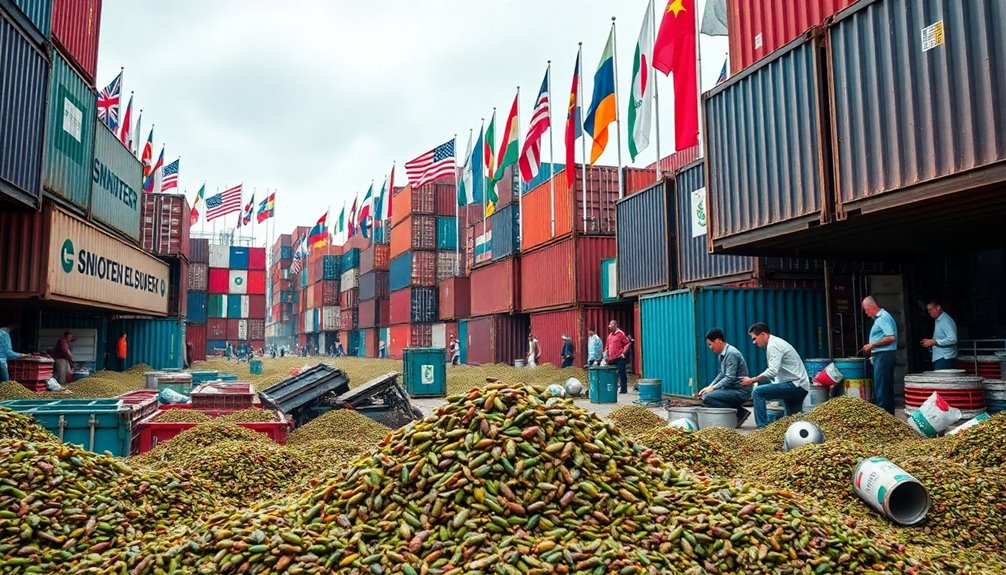
As trade tensions escalate, U.S. importers are grappling with supply chain disruptions that threaten the availability of their favorite teas. The U.S.-China trade war has resulted in a 17% drop in tea imports from China. This means less of the tea you love might be on the shelves!
With tariffs on Chinese tea reaching as high as 30%, many legal importers face higher costs. This situation makes it tricky for specialty tea retailers to manage their prices and keep their shelves stocked.
But not all is lost! Many importers are looking for alternative suppliers. For instance, imports from Sri Lanka have jumped by 15% as companies seek new sources. This shift is exciting because it opens up new flavors and types of tea that you mightn't have tried before!
However, the overall uncertainty in the market means that it's hard to predict how the supply chain will hold up. Prices may change, and availability can fluctuate.
Practical Applications
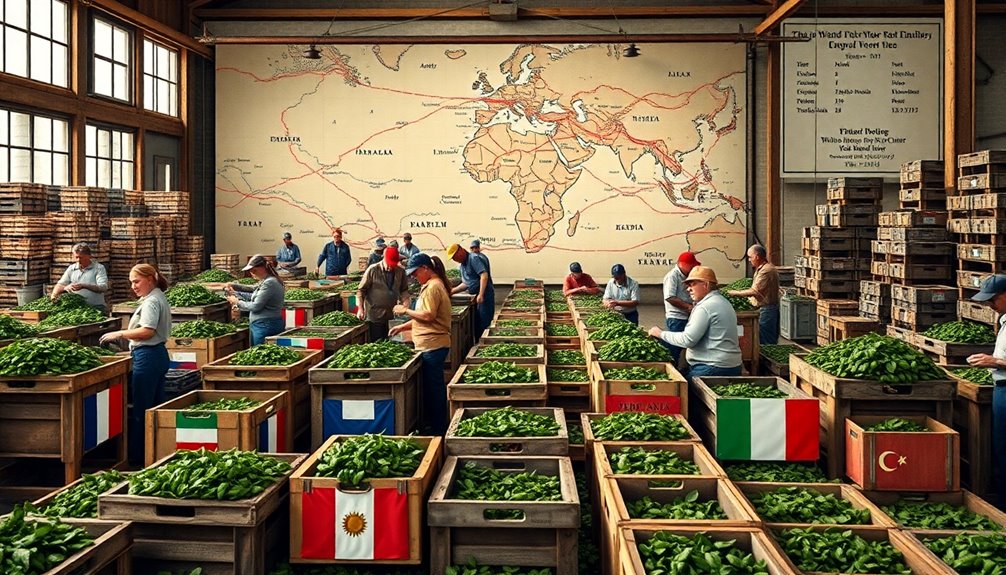
Navigating the current tea market requires savvy choices, especially with the impact of trade wars on availability and pricing. With a 17% drop in tea imports from China, many American importers are now looking to sources like Sri Lanka, which has seen a 15% rise in imports. This shift can be exciting, as you might discover new flavors and options!
However, keep an eye on tariffs. These extra taxes on premium Chinese teas have caused specialty tea retailers to raise their prices. This means that consumer prices for tea and coffee may go up, which can affect your buying decisions.
The U.S. tea industry, valued at $17.9 billion, feels the pinch too, as higher production costs make it tougher for businesses to thrive.
As you shop for your favorite brews, remember that the average tax on imports has skyrocketed from 3% to nearly 20%. This change has led to American businesses paying over $66 billion in import duties!
Frequently Asked Questions
What Country Was Profiting From Trade in Tea?
You'll find that Britain historically profited immensely from the tea trade, especially during the 18th and 19th centuries, thanks to the East India Company's monopoly, which allowed them to control prices and maximize profits.
What Are the Consequences of the Trade War?
You'll notice rising prices and fewer options as the trade war unfolds. Import tariffs raise costs, shifting your purchasing habits and impacting your favorite tea brands, ultimately affecting your overall spending and enjoyment of tea.
What Was the War Because of Tea?
You'd find that the war over tea began in the 17th century, sparked by competition between the Dutch and English. It escalated into conflicts like the Opium Wars, fundamentally altering trade dynamics and global relationships.
How Did Tea Create a Trade Imbalance Between the British and the Chinese?
Tea created a trade imbalance because you imported vast amounts from China, yet exported little in return, prompting significant silver outflows. This imbalance led you to seek alternative trade, eventually introducing opium.
Conclusion
In conclusion, trade wars are shaking up the tea industry in surprising ways! With new tariffs, tea prices can change, making your favorite drink a bit more expensive. Countries are also looking for different places to get their tea. These shifts can affect how we enjoy tea at home and in cafes. Even though it sounds tricky, it's exciting to see how the tea world adapts. So, keep sipping and exploring new flavors!

